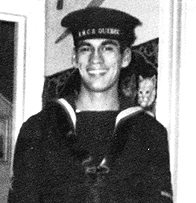A Decade of Service

Ron Lowry's ancestors include Veterans of the American Civil War and the Boer War. During the Korean War, Lowry kept watch from the Nootka for enemy submarines and torpedoes, and also participated in demolition raids on-shore. The sailor remained in the navy after the war, and is shown here in 1955. (Ron Lowry)
Both sides of my family had served in the army for as far back as we can trace, which is the Boer War on my paternal side and the War between the North and South in the United States, on my maternal side . . . . It was only natural that I would volunteer.
Originally from the Mohawks of the Bay of Quinte Band near Trenton, Ontario, Ronald Lowry was 17 when he applied to join the RCN in 1949, during what he calls "a quirk of fate":
My friend wanted to join the RCN to learn a trade. I was a two-year plumber's apprentice in Oshawa and went with him, for company . . . . When we got there, I was asked if I wanted to try the tests. I was told it would be about a two-hour wait, so I tried them . . . . I passed and it just evolved from there.
Lowry's first posting was to HMCS Cornwallis at Deep Brook, Nova Scotia, for new entry training. In August 1951, he was transferred to HMCS Nootka, where he received instruction in his chosen trade, sonar. Six months later, he sailed on the Nootka for its second tour of duty in the Far East. He was the only Indigenous sailor aboard.
Lowry wanted to help the South Koreans because he felt some empathy with them. His ancestors had been displaced from their homeland in New York State as a result of the American Revolution. As he explains, "I felt that my land had been taken away from me and I would help anyone to keep theirs."
On board the Nootka, Lowry worked in the control room, where he kept watch for enemy submarines and torpedoes. He also served on shore. Along with his sonar experience, Lowry had received demolition training, which was put to use when he was detached from the ship for six months to work with South Korean and British marines. In commando-style raids on islands and the mainland, they destroyed enemy bridges, railways and other strategic installations.
The Nootka returned to Canada in November 1952. Lowry remained in the navy after the war, attaining the rank of petty officer. In addition to the Nootka, he worked aboard mine sweepers, cruisers and patrol vessels. Three of his nearly 10 years of naval service were spent in England attached to the Royal Navy in submarine service. In all, he "went around the world twice and stopped in 62 countries—I enjoyed every minute of it." 96
When he retired from the RCN in 1960, Lowry resumed his plumbing and welding trades. Family tradition appears strong. His wife, Joan, a Mi' kmaq from Nova Scotia, was a Wren—a member of the Women's Royal Canadian Naval Services—for three years in the early 1950s. Four of their five sons have served in the navy—two are still serving. One was transferred to the Persian Gulf during the 1991 Gulf War; however, the war ended just as he was arriving.
- Date modified: